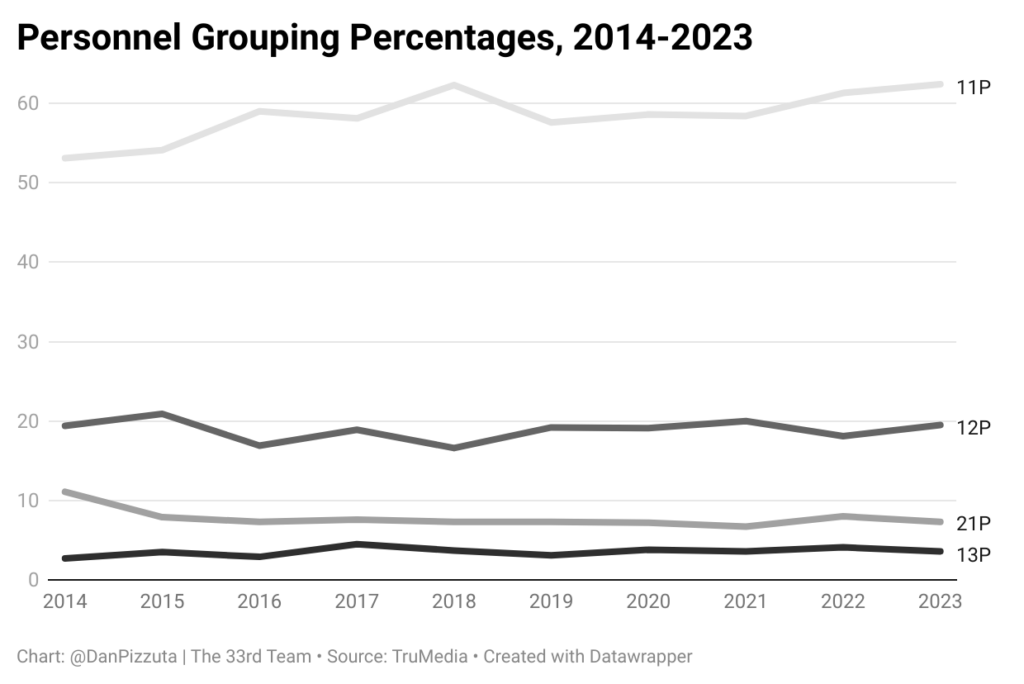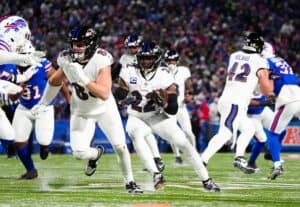In the ever-evolving NFL scheme wars, offenses are going big again
The spread revolution, which swept through college playbooks in the early 2000s, matriculated to the NFL about a decade ago. Prior to this, most offenses based out of 12 or 21 personnel, meaning they had two receivers on the field with two backs or two tight ends. Pro offenses were hesitant to embrace the full spread, which used four-receiver, 10-personnel formations, but they were willing to get lighter and faster. 11-personnel, meaning one tight end, one back and three receivers, was the norm in the league by 2010, and has grown in frequency ever since.
Overall, 11-personnel usage reached a high of 63% in 2023. With a continued emphasis on the passing game, and with contemporary schemes that use the width of the football field as much as its length, 11-personnel is without question the dominant grouping league-wide.

From 2014-2017, every NFL team took the majority of its snaps from 11-personnel. But in 2018, San Francisco bucked that trend. The 49ers, in large part because of talented fullback Kyle Juszcyk, ran 41% of their plays from 21-personnel (two backs, one tight end, two receivers), and 39% from 11-personnel. This wasn’t a huge departure from the norm, but it did signal a shift.
In 2019, two teams — Minnesota and Philadelphia — ran more plays from a non-11 grouping. Their preference was 12-personnel, with a second tight end replacing one of the receivers. Philly took a league-high 52% of their snaps from 12-personnel, with 41% coming from 11-personnel, while Minnesota used 12-personnel 34% of the time and 11-personnel just 25%. Minnesota’s percentage of 11-personnel snaps was the lowest of any team in the league since 2011.
The trend towards bigger personnel increased slightly until 2022, when the Baltimore Ravens blew it out of the water. Under coordinator Greg Roman, Baltimore ran just 12% of their plays from 11-personnel. Their favorite grouping was 22, which they used 32% of the time. This put two tight ends and two backs onto the field, one of whom was a fullback. So, rather than utilize three receivers, as most teams were doing, the Ravens essentially used three tight ends. Baltimore finished second in the NFL in rushing that season, proving a ground-and-pound attack could still be successful in the league.
Since then, teams like Atlanta, Pittsburgh, New England, Kansas City and Tennessee have followed suit. Each has incorporated big groupings at high frequencies in some fashion. In 2023, the Falcons, under then-head coach Arthur Smith, ran 11-personnel on just 16% of their snaps. Smith brought that offense to Pittsburgh in 2024, where the Steelers led the league in 13-personnel groupings. Baltimore, under new coordinator Todd Monken, remained a big-personnel team, running 11 just 27% of the time. The Saints used it just 33%. The Dolphins 38%.
So, while 11-personnel remains the most common grouping in the league, many teams are moving away from it and going bigger instead. Why might that be?
On my “Call Sheet Daily” podcast on Monday (see link below), I discussed how the linebacker position has evolved throughout the league over the past decade. In order to defend the speed offenses were putting on the field in their 11-personnel groupings, defenses countered with more sub-packages, often replacing linebackers with nickel defenders. They also came to favor a new breed of smaller, swifter backers. Downhill run-thumpers like Tedy Bruschi and Ted Johnson, the starting linebackers on New England’s 2004 Super Bowl championship team, each weighed about 250 pounds. Players in their mold had become dinosaurs by 2014. In their place were elite athletes like Fred Warner and Matt Milano, both of whom weighed around 225 pounds, and could defend the pass and play in space as well as fit the run. They were hybrids in that sense, closer to Seattle safety Kam Chancellor than to Bruschi or Johnson.
https://open.spotify.com/episode/7CHWCUfB4HNw1r3gGrf8cF?si=Y4v7b6UZRmimEh90nlLkEg
That counter move on the defensive side of the ball has prompted offenses to go big again. As defenses got lighter and faster to match the 11-personnel revolution, offenses looked to bully them with bigger personnel. First it was the 49ers, then the Ravens, and now we see it spreading. Not like a wild-fire. More like a slow burn. But it’s burning, nonetheless.
How far will it go? It’s hard to say. Each year, a new crop of quarterbacks trained in read-option systems gets drafted into the league. Those systems tend to be 10 and 11-personnel based. But big-time programs like Michigan, Alabama and Notre Dame are leaning into power systems as well. So, the college game isn’t as spread-heavy as it was a decade ago. And, with the influx of great tight ends we’ve seen enter the league the past few seasons — guys like Brock Bowers, Sam LaPorta, Trey McBride and Jake Ferguson — and with new potential stars like Tyler Warren and Colston Loveland entering now, it feels like NFL teams are investing in tight ends more than ever. A 12-personnel renaissance may be underfoot.
One thing is certain: no matter how offenses adjust, defenses won’t be far behind. It’s a constant chess match. At present, the offenses are about to move. And that move seems to be they are going big again.
